The Origins of the Modern Acoustic Guitar
Stringed instruments similar to the acoustic guitar have evolved throughout history dating back to over 4000 years ago.

The Lute Family
Ancient instruments that led to the evolution of the modern acoustic guitar were called lutes. Evidence of lutes can be seen in ancient art from Egypt as well as other forms of art from different civilizations and historical eras. Lutes have a rounded back with a teardrop shaped body with strings stretched across a wooden neck. The necks of the lute have varied throughout history, but the short-necked lutes evolved into more modern instruments.
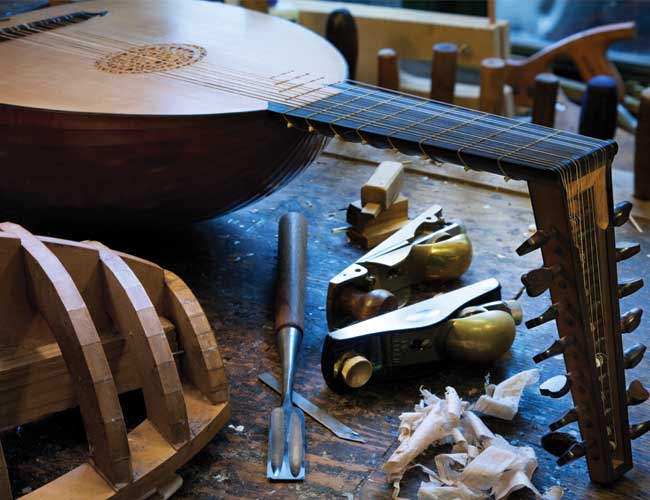
The Gittern & Mandora
Ancient lute instruments have a large family of stringed instruments, two of them being the gittern and the mandora or mandore depending on the region. These instruments were starting to be played during the Middle Ages throughout Europe and used animal gut for strings. This was common until nylon and other forms of guitar strings came into existence. The gittern was called a guiterna in Spanish, chitarra in Italian, quintern in German, and guiterre or guiterne in French. At some point in history the clarity of the name gittern being referred to as a mandora and vice versa.
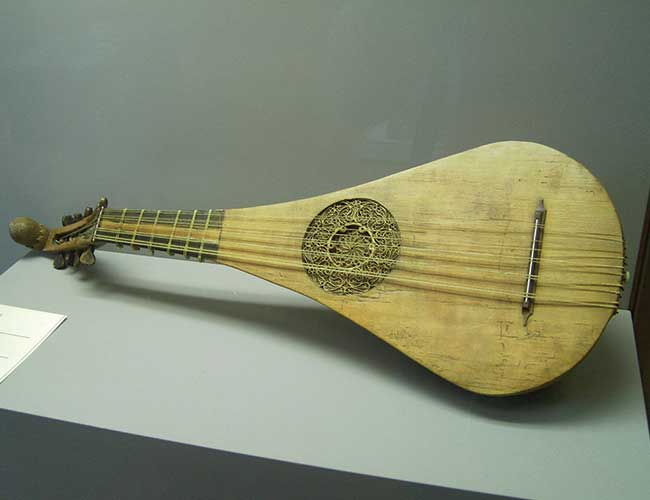
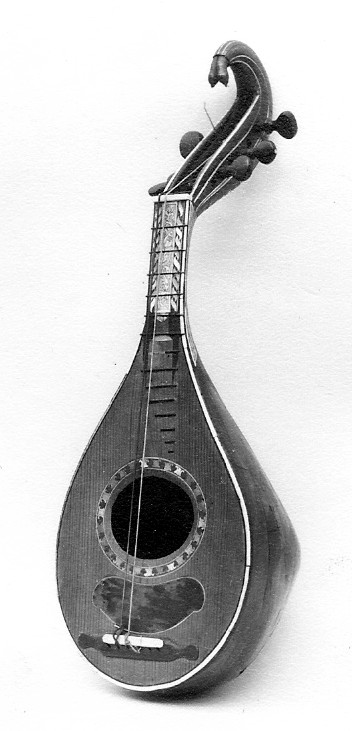
Gittern (left), Mandora (right)
The Vihuela
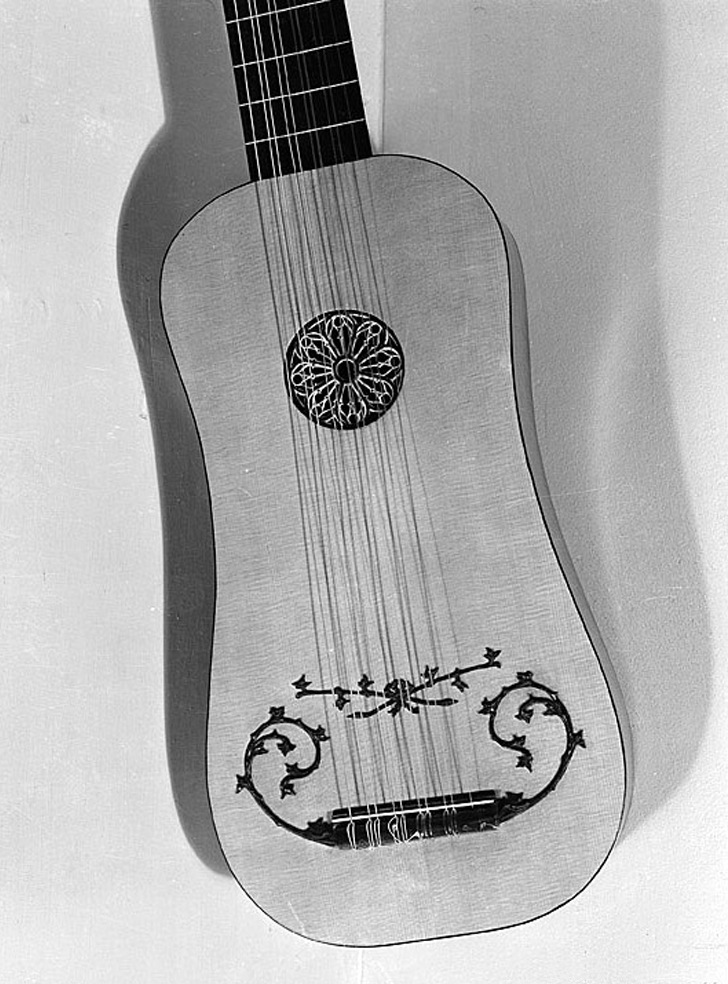 Vihuelas originated in Spain during the Renaissance of the 16th century. Vihuelas were constructed similar to other instruments like lutes and modern violins, but the body was shaped in the figure eight form with a flat back. Eventually more strings were added slowly taking the shape and structure of the classical guitars we use now. Around 1790 production of the vihuela was mostly the six-course vihuela with 6 pairs of strings tuned in unison.
Vihuelas originated in Spain during the Renaissance of the 16th century. Vihuelas were constructed similar to other instruments like lutes and modern violins, but the body was shaped in the figure eight form with a flat back. Eventually more strings were added slowly taking the shape and structure of the classical guitars we use now. Around 1790 production of the vihuela was mostly the six-course vihuela with 6 pairs of strings tuned in unison.
The Baroque Guitar
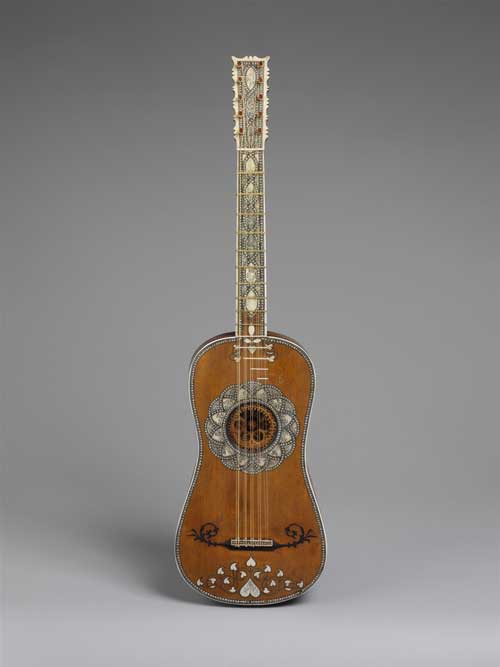 Baroque guitars became more popular than the Renaissance's lutes as far as commonly owned instruments. Baroque guitars have 5 pairs, or courses, of strings tuned in unison. These guitars first started being noted in the 1500’s.
Baroque guitars became more popular than the Renaissance's lutes as far as commonly owned instruments. Baroque guitars have 5 pairs, or courses, of strings tuned in unison. These guitars first started being noted in the 1500’s.
 Antonio de Torres Jurado
Antonio de Torres Jurado
Around 1850 spanish luthier and guitarist, Antonio de Torres Jurado, began altering the body size and using fan bracing patterns to improve the structure and sound the guitar produced.
His designs were notably the first to take the shape of the modern classical guitar, and his designs and techniques are still being used by luthiers today.
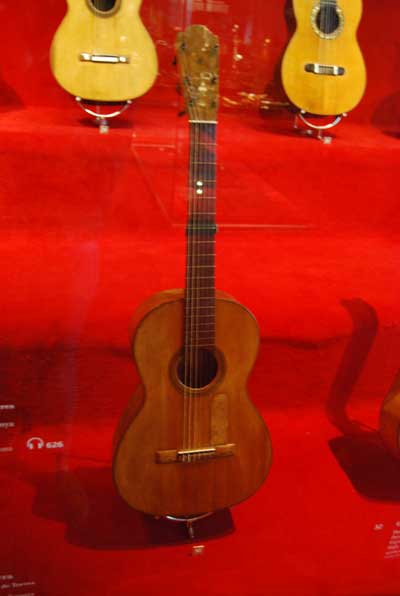
1862 Torres Guitar
Classical Guitars
Classical guitars are very similar in appearance to flamenco guitars, but are typically made with rosewood for the back and sides and a top made of cedar or spruce. The wood used for the top or soundboard is usually thicker than a flamenco guitar making its sound much different. Classical guitars typically have a rosette, but are usually seen without pickguards since the strings are usually played with the fingers rather than a pick.
Flamenco Guitars
Flamenco guitars are traditionally made using Spanish cypress for the back and sides, and spruce for the top of the guitar. Flamenco guitars use thinner wood for the top or soundboard, and are usually slightly smaller in size than a classical guitar. To protect the guitar's surface from the rhythmic tapping of the fingers, a pickguard or, golpeador, is sometimes found at both sides of the sound hole. Wooden tuning pegs are traditionally used on flamenco guitars because they increase the attack of the strings. The strings are typically set lower to the fretboard compared to classical guitars.
Modern Acoustic Guitars
Modern acoustic guitars were only called guitars until the creation of the electric guitar. Acoustic guitars are made using different types and combinations of wood. The guitar’s sound is characterized by the different types of wood and dimensions of the guitar’s body. There are several types of acoustic guitars including classical and flamenco guitars that are strung with nylon strings.
Most acoustic guitars come in 6 string or 12 string variations, but there are many custom made guitars that include more strings and or other features. Acoustic guitars are popular with blues, jazz, rock, folk and country styles, though it has a smaller volume compared to that of an electric guitar used in these genres.
Twelve string guitars use 6 courses of strings . In standard tuning, the low E string up to the G string, the smaller gauge strings are tuned an octave higher than the normal gauge strings. The B and high E strings tune in unison to make a pair of the same noted strings. Example: eE, aA, dD, gG, bb, ee
Acoustic guitars made today often come equipped with a piezoelectric pickup allowing it to be plugged into an amp or directly into a mixer. These pickups are often installed in the bridge under the saddle. Other acoustic pickups are placed in the sound hole under the strings. Before these types of pickups, the guitar was an instrument that did not produce as much volume as other instruments it was commonly accompanied with. As you will read in the Electric Guitar section of this site, during the big band and swing era, a shared effort began to amplify the guitar.
Flat-top Guitars
Flat-top guitars refer to another type of acoustic guitar and perhaps one of the more common types. Flat-top acoustic guitars are similar to classical guitars, but differ in body structure and often size for reinforcement to the tension of the steel strings used instead of nylon like the classical guitar. With steel strings and more string tension it's very common to use a pick to pluck the strings. A pickguard is found under the sound hole with the rosette. The bodies of flat top guitars are usually made wider and deeper, giving it different sound characteristics than a classical guitar.
Archtop Guitars
Archtop guitars were produced by Gibson® Guitars founder, Orville Gibson around the 1890's. Inspired by the violins design, archtop guitars use flatwound, steel strings. Archtop guitar bodies are curved rather than flat and have f-holes like a violin. These guitars became very popular with country and jazz guitarists and are also common in swing and big band. Luthiers began making archtops with humbucker pickups, making the guitar electric as well as able to be played acoustically.
Resonator Guitars
Resonator guitars came about from attempts to make the acoustic guitar louder prior to electric guitars and amps. These guitars are similar to flat-top acoustic guitars in structure, but use a metal resonator mounted to the top of the guitar. These guitars are typically used in slide and blues and come in a couple different neck types. The square neck resonator guitar is played face up on the lap using a slide. Round neck resonator guitars can also be played this way, but are not limited to this position like the square neck resonator.